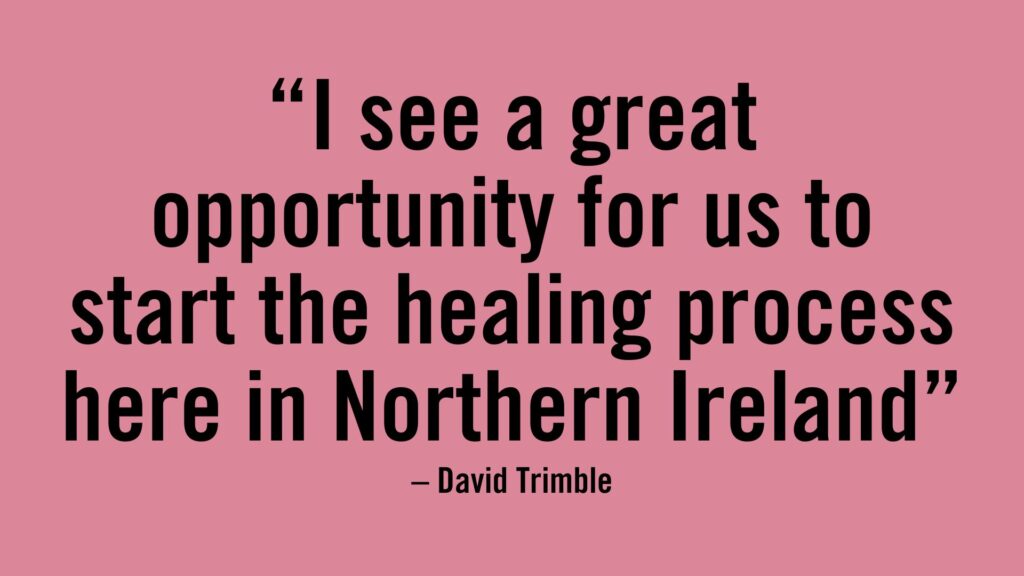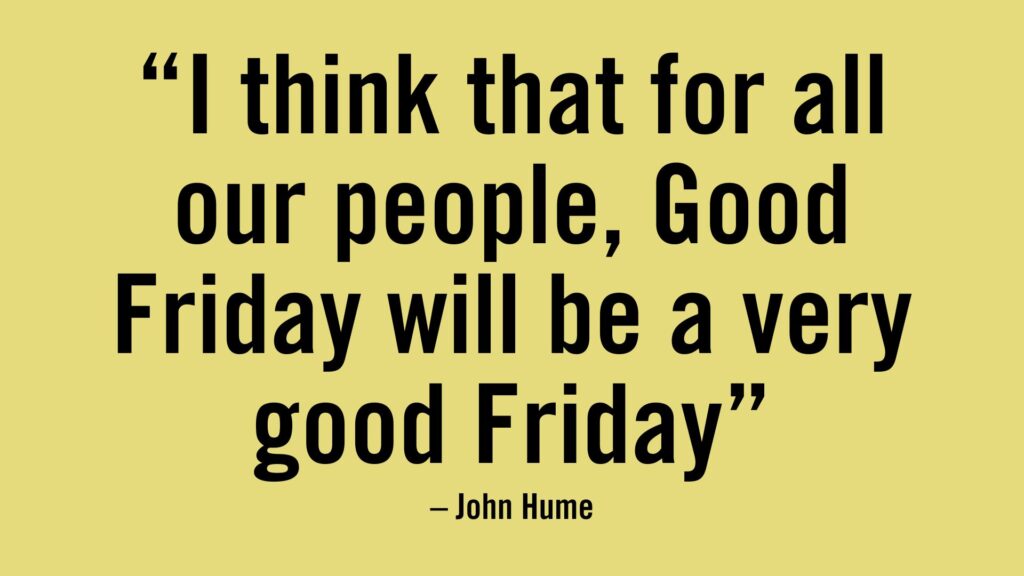The Agreement
Finalising the Agreement
After several months of intensive negotiations, walk-outs, and suspensions, an agreement was eventually reached in Belfast on 10 April 1998, which was coincidentally Good Friday.
The document’s official name is the Belfast Agreement, which is used by the British Government and unionists in Northern Ireland, while it has come to be known internationally as the Good Friday Agreement.
The Belfast/Good Friday Agreement contains two separate agreements:
- A Multi-Party Agreement between most political parties in Northern Ireland
- An international agreement between the British and Irish governments.
The Multi-Party Agreement was signed by 8 political parties in Northern Ireland:
- Alliance Party
- Labour Party NI
- Northern Ireland Women’s Coalition
- Progressive Unionist Party
- Sinn Féin
- Social Democratic and Labour Party
- Ulster Democratic Party
- Ulster Unionist Party







The Belfast/Good Friday Agreement
Constitutional issues:
- The Agreement stated that Northern Ireland will remain to be part of the United Kingdom unless a majority of people in Northern Ireland and the Republic of Ireland seek to change that
- The Agreement drafted amendments of Articles 2 and 3 of the Irish Constitution to replace its territorial claim to the island of Ireland with an aspiration for Irish unity
- Under the Agreement, people in Northern Ireland have the right to identify as Irish or British, or both, and have the right to both British and Irish citizenship
The Agreement contains three strands:
- Strand One: A 108-member Assembly elected by pr/single-transferable vote with inbuilt checks and balances to ensure cross-community power sharing
- Strand Two: A North/South Ministerial Council to develop consultation, cooperation, and action between those with executive responsibilities in Northern Ireland and the Irish government
- Strand Three: A British-Irish Council to strengthen relationships between the United Kingdom and Ireland and facilitate cooperation on areas of mutual interest
The Agreement also set out a range of measures to address ‘troubles’ related issues, such as:
- A commitment to use any influence to achieve decommissioning of all paramilitary arms
- Progress towards the objective of normal security arrangements in Northern Ireland
- An acceleration programme for the release of prisoners convicted of scheduled offences
- An independent commission on policing
As well as new institutions to safeguard human rights and equality:
- A Northern Ireland Human Rights Commission
- An Equality Commission for Northern Ireland


Reaction and Referendums
Before the Agreement could be ratified, the electorate in Northern Ireland had to accept its terms, while voters in the Republic of Ireland had to approve the proposed amendments to the Irish Constitution.
Yes or No?
In the interim, proponents and opponents of the Agreement pursued campaigns to win over the public. While all party leaders who signed the Agreement campaigned for a ‘YES’ vote, some members of the Ulster Unionist Party (UUP) rejected the agreement, as did the entirety of DUP and the UKUP. Anti-agreement unionists campaigned as the ‘United Unionists.’ Republican Sinn Féin also rejected the agreement.
“IT’S YES!”
Both referendums were held on 22 May, 6 weeks after the Agreement was signed. In Northern Ireland, 81% of the electorate turned out, 71.1% of whom voted ‘yes’ to support the Agreement, while 28.9% voted to reject it. In the Republic of Ireland, the turnout was 56%, of whom 94.4% voted to approve the constitutional changes, and 5.6% voted to reject them.










Oral Histories
During 2023, as part of the Origins and Legacies: The Belfast/Good Friday Agreement project, oral history interviews were undertaken at The Linen Hall which documented people’s experiences of and attitudes towards the Agreement in 1998, and 25 years on. We are grateful to everyone who shared their insights, and a selection of the oral histories are available to listen to via each section of this digital exhibition.
Artefacts
THE PROJECT
To mark the 25th anniversary of the Belfast/Good Friday Agreement, The Linen Hall launched a project to explore its origins and legacies. Through an exhibition, a series of events, and an oral history project, we reflected on the processes that led to the accord, the competing sides of the referendum campaign and its impact.
ORIGINS
The Belfast/Good Friday Agreement was the culmination of years of talks and negotiations between individuals and groups locally, nationally, and internationally which aimed to stop the violence which had been ongoing since the late 1960s and create a consensus for the future political framework of Northern Ireland.
LEGACIES
By the end of May 1998, the Belfast/Good Friday Agreement was signed and endorsed. The challenge then was to implement its terms, beginning with elections to the first Northern Ireland Assembly. 25 years on, Northern Ireland is a more peaceful place but some divisions have endured, and violence has occurred at times.






